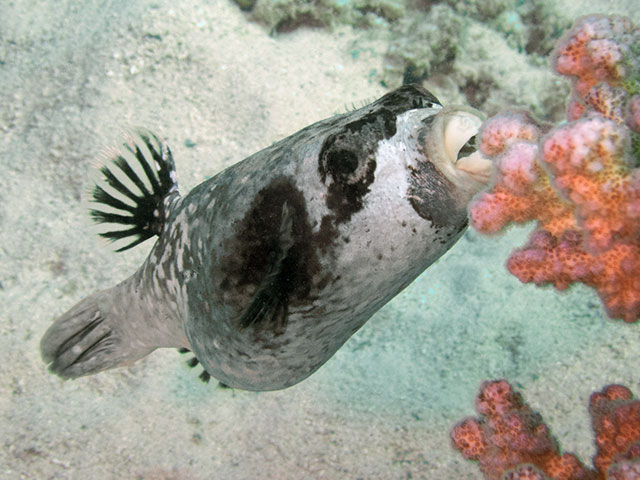Reviews: "Love the newsletters! Keep them coming" Janice Fleming...MORE REVIEWS

Masked Puffer, Amongst the Most Poisonous of Marine Life

Photo copyright Tim Nicholson.
Taken on Sha'ab Hassan, Egyptian Red Sea.
Masked Puffer, Arothron diadematus (Rüppell).
Distinctive looking, this small pufferfish has a black mask over its eyes reaching back to its pectoral fins, and a black mouth. It is common on fringing coral reefs in the Red Sea. Elsewhere it is replaced by Arothron nigropunctatus (the Blackspotted Puffer). However, some experts believe these to be the same species.
Masters of Self Defence
Pufferfish are bulbous fishes with a scaleless, prickly, skin. They are called pufferfish because when threatened they greatly inflate themselves with water, making themselves look much larger than they usually are. They do this by rapidly gulping water into their extending stomach. This makes them into a spiny ball three to four times their normal size. It can be stressful to the puffer fish though, so they only do this when seriously threatened. This defence mechanism is important because they move so slowly through the water.
Their second line of defence is their toxicity.
100 Times as deadly as the venom of the black widow spider
The Puffer is harmless, unless eaten. The liver, intestines, gonads and skin are highly poisonous and cause death in around 60% of people who eat it. If prepared properly the puffer (or fugu) is edible and considered a delicacy in Japan and Korea.

The Puffer's toxin - tetrodotoxin - is produced within the pufferfish by bacteria. The fish acquire the bacteria by grazing on the reef and eating molluscs and other invertebrates. Weight-for-weight, tetrodotoxin is up to 100 times as deadly as the venom of the black widow spider and one of the most poisonous natural substances.
Pufferfish tetrodotoxin used to treat tumours
Researchers have shown that the masked pufferfish's toxin can be used to treat breast cancer, increasing lifespan by 46% and decreasing the number of tumour cells.
Fused teeth which never stop growing
Adult puffer fish have just four teeth, fused together into one strong beak. They can use this to open clams or mussels, and graze on coral. These teeth can regenerate indefinitely, so they never become completely ground down. The four teeth gave rise to the name of their family: Tetraodontidae. This also gave rise to the name for their toxin, tetrodotoxin., so named in 1894 by Dr. Yoshizumi Tahara.

References
Jill Studholme, 10 Fascinating facts about puffer fish - the most poisonous fish on the planet, SCUBA NewsFM Fouda, Anti-tumor activity of tetrodotoxin extracted from the Masked Puffer fish Arothron diadematus, Egyptian Journal of Biology
Tetrodotoxin Poisoning Associated With Eating Puffer Fish Transported from Japan
Jim Johnson, Tetrodotoxin...an ancient alkaloid from the sea...

